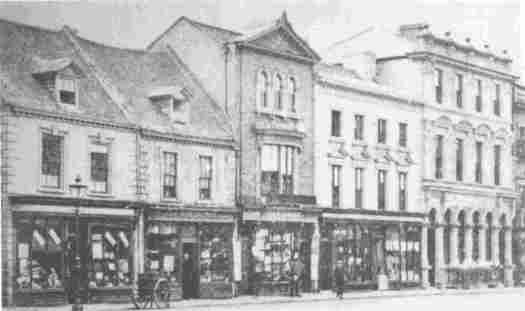| Name | Thomas SHARMAN |
| Birth | 1796, Pinchbeck |
| Death | 7 Sep 1883, West St, Holbeach, Spalding, UK Age: 87 |
| Burial | Grave 90E, 12 Holbeach Rd, Cemetery, Holbeach |
| 1 | Elizabeth SMITH |
| Birth | 1795, Deeping, St James |
| Death | Apr 1877, Holbeach, Spalding, UK Age: 82 |
| Burial | 7 Jul 1877, Grave 90E, 12 Holbeach Rd, Cemetery, Holbeach Age: 82 |
| Occupation | Butter Market |
| Children: | Charles Thomas (1827-1902) |
| Mary Ann (1820-) | |
| Isaac (1824-) | |
| John (1826-1900) | |
| William (1832-) | |
| Betsy (1833-) | |
| George (1835-1900) | |
| Matthew (1837-1915) |
Lived 107 Market Place, Spalding shoemakers shop and residence. (Census 1851)
Post office directory of Lincolnshire 1861 page 243 list Sharman Thomas boot & shoe maker, Market Place.
White's Directory of Lincolnshire, 1872, page 765 list's Sharman Thomas boot & shoe maker , Arcade ; h 5 Spring Garden's .

Market Place Spalding
He was appointed trustee of the Spalding General Baptist Chapel 16 October, 1857, then described as Cordwainer. (a worker
in cordovan leather,
1 : a soft fine-grained coloured leather
2 : dense nonporous leather tanned from the inner layer of horsehide )
From the news cutting book "Spalding" No 463 (61) in the SGS Library
"Am old and muched loved respected Spalding tradesman, Mr Thomas Sharman , died in the
neighbourhood town of Holbeach on Sunday last, aged 87. He was brought up as a Shoemaker, and for many years lived on the site of the railway station. Before the present
railway station was built the site was known as Sharman's Green. The Deceased was in many respects a remarkable man: he was self educated, was a great reader, had an excellent memory, and made himself thoroughly
acquainted with the works of many of our best authors, especially the poets, of whom Milton and Cowper were probably his greatest favourites. As a preacher and speaker he was always listened to with great pleasure by the General Baptist community."
History
The name Spalding is from the Old English spald+ingas, meaning "ditch or trench settlement". In the 1086 Domesday book, the village is given as Spallinge and in 1115 as Spaldingis.
-
Spalding was fortified and held by the Romans.
-
Before the Norman Conquest, Spalding was the manor and one of the seats of the Earls of Mercia. It is believed to be older than Crowland.
-
A castle from Mercian times was sited at the north entrance of the town.
-
After the Norman Conquest, William I gave Spalding to his nephew, Ivo TAILBOIS, Earl of Angiers. Ivo died in 1114 and is buried in Spalding.
-
The first drains around Spalding were built in the 1590s.
-
The High Bridge over the Welland River was rebuilt in 1838.
-
The Corn Exchange building was erected in 1855-6. The nearby Butter Market was opened in 1857. The police station was built in 1858.
-
In 1860 an Act was passed for supplying the town with fresh water piped in from Bourne.
-
Spalding was a railway hub for the Great Eastern and Great Northern railways, with branch lines leading to Peterborough, Bourne, Stamford, Holbeach and Lynn, March and into East Lincolnshire.
In recent years the independent bookshop Bookmark of 20 The Crescent, Spalding, have published the "Aspects" series of Books by Michael J Elsden including: "Aspects of Spalding 1790 to 1930" in 1986, "Aspects of Spalding, People and Places" in 1989, "Aspects of Spalding Villages" in 2000, "More Aspects of Spalding" in 2001 and "More Aspects of Spalding Villages" in 2003.